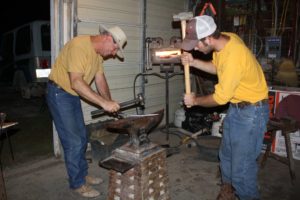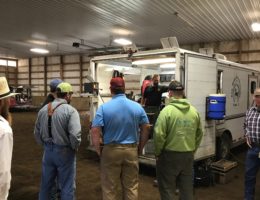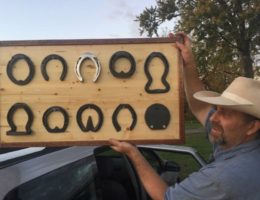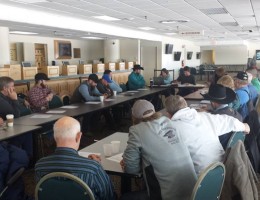Member Spotlight – Mike Stanley

I grew up really having a love for horses and anything to do with cowboys, ranching, rodeo – the whole western lifestyle. But all hope of that becoming a reality for me was sidetracked when my parents divorced. Just when I was getting started in 4-H and I had my own horse that I planned to show at the County Fair. I lost my horse and all my friends when my Mom moved my sister, brother, and I to Des Moines.
Horseshoeing looked like a good way to get back on track with what I wanted for my life. Also, being independent and self-employed really appealed to me. Making a living for myself and working with horses sounded like a good combination.
When I was 19, I shocked all my city friends and probably most of my family when I went to horseshoeing school. I enrolled in the eight week course at Bud Beaston’s Oklahoma Farrier’s College in Sperry, Oklahoma. I had a great time at school. I really enjoyed riding in the old school bus going to horse farms and ranches all over NE Oklahoma. Plus, I was learning a trade. One of the best things about Bud Beaston’s school was that you usually had plenty of horses to work on. I had such a good time, that when I graduated from the eight week course, I enrolled in the 20 week course. My eight week friends thought that I was crazy! I just felt there was more I wanted to learn. When you were a 20 week student, you helped teach the eight week class. Which sounds crazy, but it really helps a person learn and understand when you are teaching someone else. Horseshoeing school was an experience I will never forget. After 20 weeks it was pretty hard saying goodbye. I will never forget the big forge room. It was awesome to have 30 plus students build a fire in their coal forge, all at the same time. Everybody hand cranking those blowers and the smoke would really roll. I remember looking around the totally smoke filled building, seeing several guys cranking their forge and dragging on a cigarette with John Anderson on the radio singing, “I’m just on old chunk of coal, going to be a diamond someday…” I still love the smell of a coal forge.
I worked as a farrier part-time for eight years before I thought I could make it on my own full-time. Most of that time I worked at a custom cabinet shop. I have always been into woodworking, so that was a pretty good job, but I sure don’t miss breathing sawdust all day. I shod horses in the evenings and on Saturdays. I never did work on Sundays. I had a beautiful young wife and two little boys at home. Horse owners would have you working ten days a week if they could. When I was making more money shoeing part-time than I was punching the clock, I went full-time and never regretted it. I remember my wife baked me a cake that was in the shape of a horseshoe and we and our two young boys had a little celebration. Did I mention that I have a really sweet wife?
One of my worst experiences shoeing horses happened not long after I returned home from shoeing school. I got a call from Living History Farms to shoe a team of three year old Belgians. I had never even trimmed a draft before, but I was young, dumb, and hungry for work, so of course I told them I could do it, no problem. All I had for a forge was a coal forge that I had built myself. I went to Des Moines Iron and bought four pairs of Diamond draft shoes and a box of nails to fit them. At the time, the Farrier’s Journal had run a really good article on shoeing the logging horse. I spent some time studying that article since they wanted heel caulks all around; which, again, I didn’t really know much about. When the big day came, the man that hired me took me out to the 1900 farm, tied up the team, and took off. Man, this was a big, beautiful team of blonde Belgians and they knew even less about shoeing than I did. Between wrestling the big colts, cutting off all those long heels, and forging caulks, it took me all morning to shoe the first one and all afternoon to shoe the second. I really worked my tail off. To top it all off, the farm was giving tours to school kids all day. There’s nothing better than getting your butt kicked by a team of Belgians than having 30 school kids crowding around watching the show and asking every dumb question ever asked of a horseshoer. That was one tough day! It took a lot of patience and determination, but I’m glad I saw it through. My Dad still has one of those shoes from that team hanging in his shop. You know the ones with the real nice forged heel caulks, just like in the Farrier’s Journal – well almost.
The Iowa Professional Farriers Association (IPFA) has been a big part of my success as a farrier. I am thankful for all that I have learned from its members and through its clinics. To be good at anything, you have to keep learning and working at being better. I was proud and privileged to serve as IPFA President for five years. Though I am not as active as I used to be, I have total respect for the IPFA and its members. I have a lot of great memories of being a part of the IPFA, the friendships, clinics, AFA conventions, etc. I will never forget the time when I injured myself and was unable to work. Many IPFA members came to my rescue and took care of my customers for me. Even to go so far as traveling to Wisconsin to take care of my reining horse barn. Thanks again to all that were there for me in my time of need!
What I like the least about shoeing horses is people. Not all them, but a lot of them. I have had a lot of good and loyal clients, but there are just very few that I respect as horsemen. Without a doubt, people are the horses’ biggest problem, too.
What I like the most about shoeing horses is working with horses. Just think about what the horse has done for the human throughout history; it is incredible. No other animal can even come close to the versatility and usefulness of the horse.
Looking back, if I could change anything about my business, I would not be so shy about charging more or raising my prices. If I could rewind my life, I think I would still choose horseshoeing as a career. It is hard to believe I have been shoeing for 36 years. But, as I look back, it’s been a good life and a good business.
The most rewarding part of my horseshoeing career is not the people I have worked for or the horses I have shod. For me it is the independent, self-reliant lifestyle and providing a living for myself and my family. I am thankful that my wife was able to stay home and be a full-time wife and mother. Together, we homeschooled and raised two fine sons. The freedom horseshoeing provided really worked well with raising a family. The flexibility has also allowed me the opportunity to pursue other interests.
My family and I have been raising Corriente cattle since 2001, known as 4S Corrientes. We started out with a few registered heifers and a bull. We have grown and maintained a registered herd. We have purchased or leased bulls from some of the top breeders in the country in our pursuit to produce quality cattle.
My son, Clint, and I are equal partners in a fencing business, Stanley Custom Fence LLC. We do a lot of barbwire, but also woven wire, hi-tensile and continuous fence panels. We also do fence removal and pasture clearing.
I got started in leather work approximately 20 years ago, for the most part, making cowboy gear for my sons and myself. Then I began to make and sell things for other people as Mike Stanley Leather. I have built saddles and made all the usual things: chaps, chinks, belts, knife sheaths, holsters, saddlebags, spur straps, and headstalls. Right now I am working on another saddle and really trying to raise my leather carving to a higher level. Making functional art is really what I am trying to achieve. I am learning about balance and flow of design that is pleasing to the eye. It is interesting what the subtle things in a design can do to hit or miss that goal of being pleasing to the eye. Just like a well prepared hoof and a well-made and balanced shoe becomes a thing of art and beauty. At least until it’s pulled off in the fence.
When our two sons joined 4-H, my wife, Karla, and I got very involved working in the Madison County Horse Project. The Project didn’t do anything that we didn’t help to make happen. We helped put on the County Fair, invitational horse shows and the County Fair Mule Show. We worked with the kids at horsemanship clinics, weekly practices and monthly roping classes. 4-H became a big part of our life. We really enjoyed working with the kids, taking part in their lives and just spending time with them at the County Fair and the State Fair. We especially had fun traveling with and chaperoning our Horse Judging, Hippology and Quiz Bowl teams. We went to Columbus, Ohio to the Quarter Horse Congress once and the National Western Stock Show in Denver, Colorado twice.
The boys and I also got involved competing in ranch horse shows. Of course, they needed help, too. I was soon elected to the Board of Directors representing SW Iowa and Karla headed the show committee. We also helped put on several ranch horse clinics and shows. Through people we met at ranch horse shows, we got involved with Big Loop ranch roping. This became what the boys and I really loved to do.
As you can see, we really got busy with horses. It was during those years that my participation in the IPFA really fell off, but you only get one chance to raise your kids and then they’re gone. We also never failed to take a family vacation; which I think is really important. What a great time we had with many memories to look back on.
Now Karla and I are what they call empty nesters. At first it was really hard to accept. We were feeling pretty broken-hearted for a long time. But we spent 18 years preparing them to be fine young men and to strike out on their own. Without a doubt, our greatest accomplishment was the raising of our sons. I would do it all again, if I could.
When I move on from this life, if people who know me can say, “Mike Stanley loved and served God, his wife, and his children”, I will be a happy, happy man. To me, that is success.







Follow us